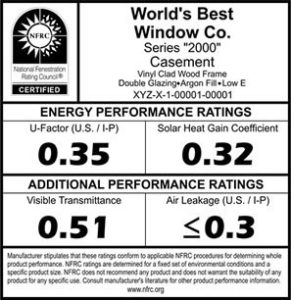When researching replacement windows, you’ve likely stumbled across two terms relating to energy efficiency: R-value and U-value. Both terms are used in the construction industry to define the energy efficiency of a given material, but there are key differences that can be confusing to understand. Choosing the most efficient windows starts with understanding the differences between R-value and U-value, and their relationship to a window’s overall energy efficiency. In this article, we’ll look specifically at U-value. Click here to read more on R-values.
What is U-Value?

Windows are a natural source of heat loss in homes and properties. During cooler months, interior heat can be transferred through the glass, and thus, windows that aren’t well insulated often result in greater heating costs. But how are the insulating properties of your window assembly determined? What types of windows are better suited to slow this natural heat loss?
A good starting point is the window’s U-value. U-value is a standardized measurement, determined by the National Fenestration Rating Council (NFRC), and simply put, it is the rate of heat loss of your window assembly. Therefore, windows with lower U-values are better insulated and help slow the natural heat loss.
Why Is U-Value Important?
U-value is an important measure for property managers, because it provides a complete picture of the window assembly. All components are used to determine U-value – which is often referred to interchangeably as U-factor. Thus, property owners can use U-factor to quickly determine which windows are more efficient and better suited to prevent heat loss. In order to determine U-factor, we calculate it based on the window’s:
- Insulation
- Frame and spacer materials
- Glass type
U-value is an inverse measure; the lower the U-factor, the better insulated the window. Thus, a single-paned window’s U-Value with a basic aluminum frame is above 1, usually around 1.25, while triple-pane windows may have U-values around .25 or lower.
How Is U-Value Determined?
U-value is a complex measurement, which is determined using a number of different factors. For instance, the number of layers of glass, the coating used on the window, and the type of frame and spacer material all factor into overall U-value. So which factors result in the best insulation?
- Coating: Windows are often covered with coating, which is an important factor in determining U-value. Windows with more substantial coating, which is often called low-emittance or low-e coating, have lower emissivity, which is the unit’s ability to radiate heat through itself. Thus, the greater the coating U-value, the better the window is at retaining heat. Low-e coating can contribute significant reduction in U-value, depending on the number of coatings and the number of panes that are coated.
- Gas Fills: Today’s double- and triple-pane windows are increasingly made with an inert gas fill between each pane. Gases like argon are sealed between the panes, and because gas is a low conductor of energy, the passage of heat is slow through the gas. In general, the increase in U-value resulting from a gas fill is fairly modest.
- Framing Materials: Heat loss through the frame can be significant, up to 15 percent or more, and thus, it’s important to consider the type of frame you install. Frames are made from a variety of materials, including aluminum, wood, fiberglass, and vinyl. Some of these materials retain heat more efficiently. For instance, standard aluminum frames have higher U-values compared to wood or fiberglass frames, because aluminum transfers heat more rapidly. On a double-pane window, for instance, a wood or fiberglass frame may half a window’s U-value.
Remember, a lower U-value is a better, more energy efficient value. - Window Spacers: In windows with more than one pane, the glass is separated by a spacer. These spacers are made from a variety of materials, but they improve the window’s ability to retain heat around its edges. Plus, windows with more space between panes of glass also slow heat loss.
- Size and Thickness of the Glass: First, the number of layers of glass is important. Double- and triple-pane windows prevent heat loss more effectively compared to single-pane windows. But the thickness of the glass is also important. Window glass can range in thickness from a few millimeters up to 10 or more. Thicker glass slows the conductance of heat. Plus, the size of the window is also important. But just because a window has more area, doesn’t mean heat loss will be greater. In fact, some larger coated windows with gas fills may have better U-values compared to smaller windows. It all depends on the combination of features that you have available to you.
What Windows Should You Choose?
In climates with very cold winters, U-value is an important factor. In these types of climates, a window with a U-factor of .30 or below can greatly reduce heating costs. In areas of the country where winters are milder, a low U-value window does offer benefits, but these types of windows aren’t always necessary.

